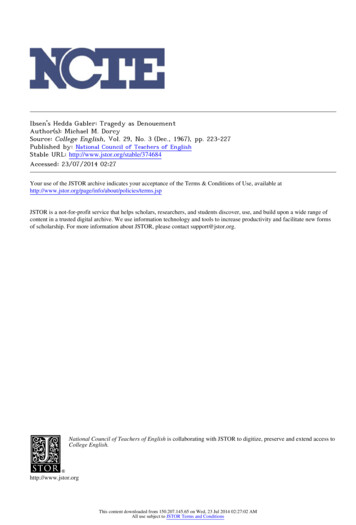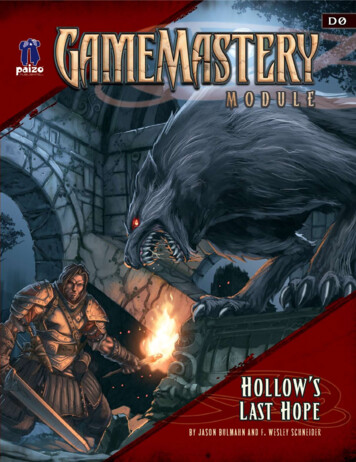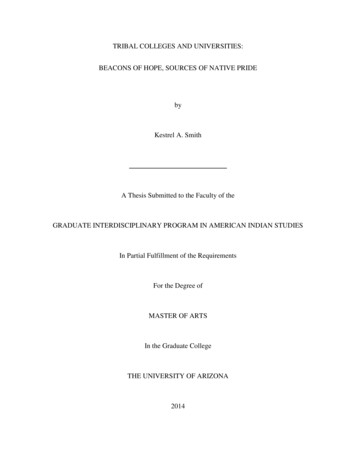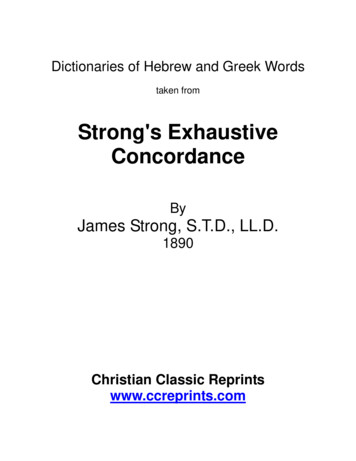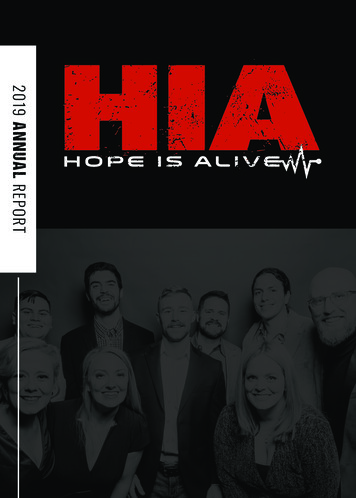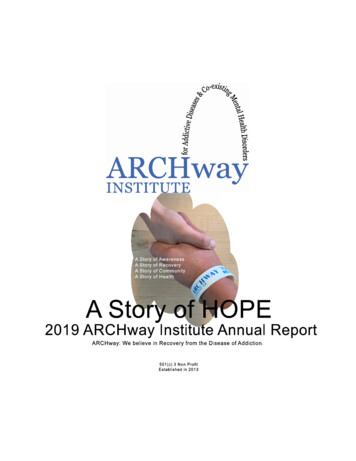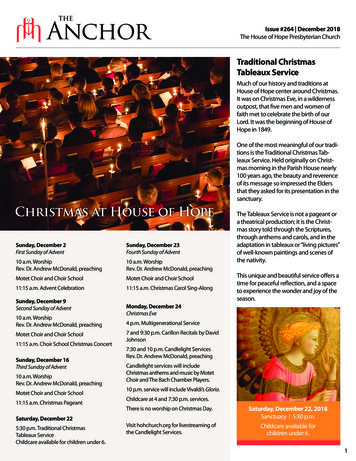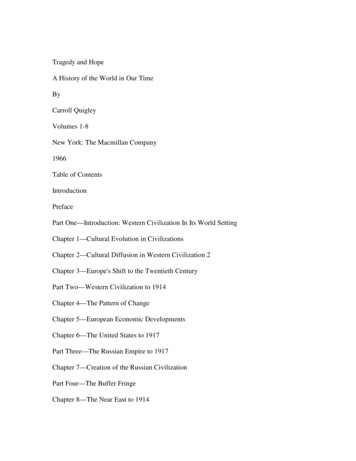
Transcription
Tragedy and HopeA History of the World in Our TimeByCarroll QuigleyVolumes 1-8New York: The Macmillan Company1966Table of ContentsIntroductionPrefacePart One—Introduction: Western Civilization In Its World SettingChapter 1—Cultural Evolution in CivilizationsChapter 2—Cultural Diffusion in Western Civilization 2Chapter 3—Europe's Shift to the Twentieth CenturyPart Two—Western Civilization to 1914Chapter 4—The Pattern of ChangeChapter 5—European Economic DevelopmentsChapter 6—The United States to 1917Part Three—The Russian Empire to 1917Chapter 7—Creation of the Russian CivilizationPart Four—The Buffer FringeChapter 8—The Near East to 1914
Chapter 9—The British Imperial Crisis: Africa, Ireland, and India to 1926Chapter 10—The Far East to World War IPart Five—The First World War: 1914: 1918Chapter 11—The Growth of International Tensions, 1871-1914Chapter 12—Military History, 1914-1918Chapter 13—Diplomatic History, 1914-1 918Chapter 14—The Home Front, 1914-1918Part Six—The Versailles System and the Return to Normalcy: 1919-1929Chapter 15—The Peace Settlements, 1919-1923Chapter 16—Security, 1919-1935Chapter 17—Disarmament, 1919-1935Chapter 18—Reparations, 1919-1932Part Seven—Finance, Commercial and Business Activity: 1897-1947Chapter 19—Reflation and Inflation, 1897-1925Chapter 20—The Period of Stabilization, 1922-1930Chapter 21—The Period of Deflation, 1927- 1936Chapter 22—Reflation and Inflation, 1933-1947Part Eight—International Socialism and the Soviet ChallengeChapter 23—The International Socialist MovementChapter 24—The Bolshevik Revolution to 1924Chapter 25—Stalinism, 1924-1939Part Nine—Germany from Kaiser to Hitler: 1913-1945Chapter 26—Introduction
Chapter 27—The Weimar Republic, 1918-1933Chapter 28—The Nazi RegimePart Ten—Britain: the Background to Appeasement: 1900-1939Chapter 29—The Social and Constitutional BackgroundChapter 30—Political History to 1939Part Eleven—Changing Economic PatternsChapter 31—IntroductionChapter 32—Great BritainChapter 33—GermanyChapter 34—FranceChapter 35—The United States of AmericaChapter 36—The Economic FactorsChapter 37—The Results of Economic DepressionChapter 38—The Pluralist Economy and World BlocsPart Twelve—The Policy of Appeasement, 1931-1936Chapter 39—IntroductionChapter 40—The Japanese Assault, 1931-1941Chapter 41—The Italian Assault, 1934-1936Chapter 42—Circles and Counter-circles, 1935-1939Chapter 43—The Spanish Tragedy, 1931–1939Part Thirteen—The Disruption of Europe: 1937-1939Chapter 44—Austria Infelix, 1933-1938Chapter 45—The Czechoslovak Crisis, 1937-1938
Chapter 46—The Year of Dupes, 1939Part Fourteen—World War II: the Tide of Aggression: 1939-1941Chapter 47—IntroductionChapter 48—The Battle of Poland, September 1939Chapter 49—The Sitzkrieg, September 1, 1939-May 1940Chapter 50—The Fall of France, (May-June 1940) and the Vichy RegimeChapter 51—The Battle of Britain, July-October 1940Chapter 52—The Mediterranean and Eastern Europe, 1940) June 1940-June 1941Chapter 53—American Neutrality and Aid to BritainChapter 54—The Nazi Attack on Soviet Russia, 1941-1942Part Fifteen—World War II: the Ebb of Aggression: 1941-1945Chapter 55—The Rising in the Pacific, to 1942Chapter 56—The Turning Tide, 1942-1943: Midway, E1 Alamein, French Africa, andStalingradChapter 57—Closing in on Germany, 1943-1945Chapter 58—Closing in on Japan, 1943-1945Part Sixteen—The New AgeChapter 59—IntroductionChapter 60—Rationalization and ScienceChapter 61—The Twentieth-Century PatternPart Seventeen—Nuclear Rivalry and the Cold War: American Atomic Supremacy:1945-1950Chapter 62—The FactorsChapter 63—The Origins of the Cold War, 1945-1949
Chapter 64—The Crisis in China, 1945-1950Chapter 65—American Confusions, 1945-1950Part Eighteen—Nuclear Rivalry and the Cold War: the Race for H-Bomb: 1950-1957Chapter 66—"Joe I" and the American Nuclear Debate, 1949-1954Chapter 67—The Korean War and Its Aftermath, 1950-1954Chapter 68—The Eisenhower Team, 1952-1956Chapter 69—The Rise of Khrushchev, 1953-1958Chapter 70—The Cold War in Eastern and Southern Asia, 1950-1957Part Nineteen—The New Era: 1957-1964Chapter 71—The Growth of Nuclear StalemateChapter 72—The Disintegrating Super-blocsChapter 73—The Eclipse of ColonialismPart Twenty—Tragedy and Hope: the Future in PerspectiveChapter 74—The Unfolding of TimeChapter 75—The United States and the Middle-Class CrisisChapter 76—European AmbiguitiesChapter 77—ConclusionIntroductionByMichael L. ChadwickIn 1965 one of the nation's leading professors quietly finished the last draft of a 1311page book on world history. He walked over to his typewriter and secured the last pagesof the book and placed them into a small box and wrapped it for mailing. He then walkedto the Post Office and mailed the final draft to his publisher in New York City. The editorwas somewhat overwhelmed and perhaps even inhibited by the scholarly treatise. Thelast thing he wanted to do was to read the huge draft. He knew and trusted the professor.
After all, he was one of the leading scholars in the western world. They had beenacquaintances for several years. He had already signed an agreement to publish the bookbefore it was finished. He had read several chapters of the early draft. They were boring,at least to him. He decided to give the book to a young editor who had just beenpromoted to his assistant. The young editor was also overwhelmed but happy to obligethe Senior Editor. The young editor was unaware of the importance of the manuscript andof the revelations which it contained. To the young editor this was just another textbookor so he thought.Somehow one of the most revealing books ever published slipped through the editorialof offices of one of the major publishing houses in New York and found it way into thebookstores of America in 1966.Five years later I was meandering through a used bookstore and stumbled upon thisgiant book. I picked up the book, blew the dust off and opened it to a page where theauthor stated that:".[T]he powers of financial capitalism had another far-reaching aim, nothing lessthan to create a world system of financial control in private hands able to dominate thepolitical system of each country and the economy of the world as a whole. this systemwas to be controlled in a feudalist fashion by the central banks of the world acting inconcert by secret agreements arrived at in frequent private meetings and conferences. Theapex of the system was to be the Bank for International Settlements in Basle,Switzerland, a private bank owned and controlled by the world's central banks whichwere themselves private corporations."It must not be felt that these heads of the world's chief central banks were themselvessubstantive powers in world finance. They were not. Rather, they were the techniciansand agents of the dominant investment bankers of their own countries, who had raisedthem up and were perfectly capable of throwing them down. The substantive financialpowers of the world were in the hands of these investment bankers (also called'international' or 'merchant' bankers) who remained largely behind the scenes in their ownunincorporated private banks. These formed a system of international cooperation andnational dominance which was more private, more powerful, and more secret than that oftheir agents in the central banks. this dominance of investment bankers was based ontheir control over the flows of credit and investment funds in their own countries andthroughout the world. They could dominate the financial and industrial systems of theirown countries by their influence over the flow of current funds though bank loans, thediscount rate, and the re-discounting of commercial debts; they could dominategovernments by their own control over current government loans and the play of theinternational exchanges. Almost all of this power was exercised by the personal influenceand prestige of men who had demonstrated their ability in the past to bring off successfulfinancial coupes, to keep their word, to remain cool in a crisis, and to share their winningopportunities with their associates."
I could hardly believe what I was reading. I sat in the bookstore and read until closingtime. I then bought the book and went home where I read almost all night. For the nexttwenty-five years I traveled throughout the United States, Europe and the Middle Eastfollowing one lead after another to determine if the incredible words of the professorwere really true. While serving as the Editor of a scholarly journal on internationalaffairs, Director of the Center for Global Studies and foreign policy advisor for a key U.S. Senator in Washington, D. C., I conducted over 1000 interviews with influential worldleaders, government officials, military generals, intelligence officers, scholars andbusinessmen, including corporate CEOs and prominent international bankers andinvestment bankers. I went through over 25,000 books and over 50,000 documents. Ilearned for myself that the professor was telling the truth.There really is a "world system of financial control in private hands" that is "able todominate the political system of each country and the economy of the world." I call thissystem the World Trade Federation. It is an ultra-secret group of the most powerful menon the earth. They now control every major international institution, every majormultinational and transnational corporation both public and private, every major domesticand international banking institution, every central bank, every nation-state on earth, thenatural resources on every continent and the people around the world throughcomplicated inter-locking networks that resemble giant spider webs. This group iscomprised of the leading family dynasties of the Canada, United States, Britain,Germany, France, Italy, Japan, Russia and China. This self-perpetuating group hasdeveloped an elaborate system of control that enables them to manipulate governmentleaders, consumers and people throughout the world. They are in the last stages ofdeveloping a World Empire that will rival the ancient Roman Empire. However, this newEmpire will rule the entire world, not just a goodly portion of it as Rome did long ago,from its ultra-secret world headquarters in Germany. This group is responsible for thedeath and suffering of over 180 million men, women and children. They were responsiblefor World War I, World War II, the Korean War, and Vietnam, etc. They have createdperiods of inflation and deflation in order to confiscate and consolidate the wealth of theworld. They were responsible for the enslavement of over two billion people in allcommunist nations—Russia, China, Eastern Europe, etc., inasmuch as they were directlyresponsible for the creation of communism in these nations. They built up and sustainthese evil totalitarian systems for private gain. They brought Hitler, Mussolini, Stalin andRoosevelt to power and guided their governments from behind the scenes to achieve astate of plunder unparalleled in world history. They make Attila the Hun look like akindergarten child compared to their accomplishments. Six million Jews were torturedand killed in order to confiscate billions of dollars in assets, gold, silver, currency,diamonds and art work from the Tribe of Judah–a special group of people. The people inEastern Europe suffered a similar fate as the armies of Hitler overran these countries,murdered, enslaved, robbed and plundered the unique people who resided there. For thelast two and one half centuries wealth and power have been concentrating in the hands offewer and fewer men and women. This wealth is now being used to construct andmaintain the World Empire that is in the last stages of development. The World Empire ispartly visible and partly invisible today.
The chief architects of this new World Empire are planning another war—World WarIII—to eliminate any vestiges of political, economic or religious freedom from the face ofthe earth. They will then completely control the earth. and its natural resources. Thepeople will be completely enslaved just as the people were in the ancient Roman Empire.While the above may sound like fiction, I can assure you that it is true. I wish it wasfiction, but it is not, it is reality.The above recitation is quite blunt, perhaps more blunt than the professor would haveliked, but he knows and I know that what I have just written is true. However, mostpeople do not want to know that such a Machiavellian group of men, spread strategicallythroughout the world, really exists. They prefer to believe that all is well and that we aretraveling down the road to world peace, global interdependence and economic prosperity.This is not true.The above professor describes the network I have just described in elaborate detail—far too elaborate for most people. That is why I am truly surprised that it was everpublished. The above fictional account of its publication may not be far from the truth.The contents of the above book will probably astound most people. Most people willundoubtedly not believe the professor. That will be a great mistake. Why? Because manyof the tragedies of the future may be avoided with proper action.If all our efforts resulted in saving just one life, wouldn't it be worth it? What if wecould save 100 lives? What if we could save 1000 lives? What about 10,000 lives? Whatabout 1,000,000 lives? What if we could free the billions of inhabitants of Tibet, China,Russia and other communist nations and ensure the survival of the people of Taiwan andIsrael? Would not all our efforts be worth it? I believe so. The tragedies occurring todayin Russia, China, Asia, Eastern Europe, Africa, Western Europe or the Middle East couldbe avoided.The apathy and indifference of people in the Western World to the suffering, torture,misery, bondage and death of millions and millions of people around the world in theyears ahead may be one of the greatest tragedies of the twenty first century.The message of the above volu
Chapter 1—Cultural Evolution in Civilizations Chapter 2—Cultural Diffusion in Western Civilization 2 Chapter 3—Europe's Shift to the Twentieth Century Part Two—Western Civilization to 1914 Chapter 4—The Pattern of Change Chapter 5—European Economic Developments Chapter 6—The United States to
